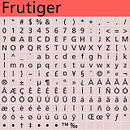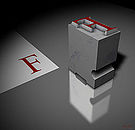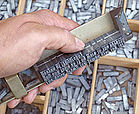Font
Typesetting font is a set of characters designed in a specific font and realized according to the respective technical conditions. It is used for text production and processing, typesetting and printing and forms the basis of typography.
A typesetting script consists of individual characters, the glyphs: usually lowercase letters, uppercase letters, umlauts, accented characters, numerals, ligatures, punctuation marks, special characters and small caps. These are assembled manually, mechanically, or electronically to form words, lines, and more complex orders. The scope of such a character set depends on the technology and the intended application radius of a typesetting font.
In the case of Western European alphabetic scripts, the functional efficiency of the characters in a typeset requires that they be arranged horizontally, in proximity to other characters in the inventory, according to a uniform rhythmic and stylistic principle. Only then can they be combined into a coherent, graphically balanced typeface.
· Different forms of character sets
· 
Type apparatus of the 42-line Bible around 1454
· 
Layout of a case for antiqua typefaces (125 compartments)
· 
Font of the "Frutiger
Origin of the first typescripts
The first typesetting script was created around 1450 by Johannes Gutenberg, who developed movable type (types) together with the hand-casting instrument. His invention made it possible to duplicate the individual letters cut into metal in a form-identical manner and then to assemble them into different printing forms that were homogeneous in themselves. This made it possible to make technical use of the advantages of the alphabetic writing system. With a manageable supply of characters, any text could be set, printed and thus reproduced in different arrangements. This modular principle is also used for digital fonts. Whether for network communication (chat, SMS, e-mail) or desktop publishing: Written statements are "composed" of individual letters.
In the days of lead type, the production of typesetting fonts was a highly specialized craft, sometimes steeped in professional secrets, practiced by a small select group of qualified type designers and stamp cutters. The design and technical realization of a typeface often took several years. Nevertheless, only fifty years after Gutenberg's invention, there were already about 2000 different typesetting fonts.
From lead typesetting to digital typesetting
Until the 1980s - i.e. for more than 500 years - a typesetting script was cast in lead. From the beginning, it was used exclusively for printing. For this reason, the various typesetting fonts were also colloquially referred to as printing type.
→ Main article: Typesetting (print)
· Hand typesetting
· 
Lead sheet with typeface "F
· 
Lines in the angled hook
· 
Typeset text in typeset ship
Casting, typesetting and printing remained manual work for more than 350 years after Gutenberg. The transition to industrial production did not begin until the 1920s, when the first typesetting machine was patented in England. Further developments prepared the way for Ottmar Mergenthaler's Linotype line-casting machine (1886). This combined type casting and typesetting into one operation and was used mainly for newspaper printing. Extensive text could be entered quickly using a keyboard. In 1897 the Monotype was invented, in which the letters were cast and assembled individually by means of storage on punched tape. These machines were only partially superseded by desktop publishing.
After the Second World War, intensive work was carried out to initially replace the production of printing plates from lead with optomechanical processes. The casting device was replaced by a film exposure chamber. With the development of phototypesetting technology, typesetting began to break free not only from its bond to lead, but subsequently also from that to film material. With the increasing use of electronic components instead of mechanical ones, the optomechanical principle was transferred to digitally operating systems. In 1965, Rudolf Hell invented the Digiset digital electronic phototypesetting system, in which the characters were generated electronically. From the mid-eighties onwards, desktop publishing (DTP) emerged, revolutionising the production methods of and with type. The technical principles behind this are still valid today. In the course of this upheaval, the design and template technology of typesetting fonts also changed several times.
Today, typesetting fonts are produced and used electronically. With the help of adequate software, they are designed in pixel or vector form and stored in encoded form in digital data formats. In the form of fonts (digital type carriers), they form the source material for type applications in printing and in virtual text presentation/processing in desktop publishing and on the web, as well as for written information on electronic computer screens and the displays of everyday devices.
Depending on the resolution requirements of the respective devices, screen fonts on the one hand and print fonts on the other are sometimes displayed in separate files. For example, special typesetting fonts are designed for mini displays of mobile output devices such as tablets, smartphones, MP3 players and digital cameras.
The elimination of technical and economic barriers means that anyone can develop a typeface with a font editor (Fontlab, Fontographer or the free editor FontForge) and offer it for sale on the Internet. Currently, it is estimated that millions of fonts are on the market. New ones are created every day all over the world.

Font editor Fontforge to create your own fonts, details with Bézier curves
Search within the encyclopedia